Both qualitative and quantitative methods apply when conducting research. Often, people who undertake projects that require analyses do not understand the difference between the two processes. Most of them mistakenly assume and use the terms interchangeably. However, it is essential to fathom the differences between the two approaches. This will help clear the common misconception that one works better than the other since they serve different purposes. Some of the differences include the qualitative method helps explore while quantitative methods help generate data.
Qualitative method is an essential aspect of research since it helps in exploring. Through this approach, the researcher gains knowledge of underlying opinions, motivations, and reasons. The approach also provides insights into the problem by developing hypotheses for potential qualitative research. The qualitative methods aid in discovering and gaining a deeper understanding of individual trends, opinions, thought, and more so experience. Hence, one does thorough research on the problem at hand.
Most of the researches that require qualitative method are used to gain an in-depth understanding of human behavior. Through the approach, a researcher attains excellent knowledge of human experiences, intentions, and attitudes. A researcher using the method gives more weight to the views of participants. This makes the techniques used in this type of research differ. During the collection of data, the researcher use questionnaires, structured interviews, or conduct surveys. The methods vary due to the use of semi-structured or unstructured techniques. The sample size is typically small, and a researcher selects respondents suitable for fulfilling a given quota.
The approach produces answers to specific case studies. Any general conclusion made beyond the survey conducted is considered tentative propositions. To understand a phenomenon during the study, the researcher must explore the entire situation, which involves symbolic interaction and phenomenology, which helps access a large amount of non-numerical data. The approach begins as a grounded theory, where the researcher seems to have no understanding of the previous phenomenon. However, the study takes an empirical and scientific route throughout the process.
Conversely, Quantitative research refers to a systematic investigation where a researcher gathers quantifiable data and compute it through performing statistical techniques. In this approach, the data is collected from the already existing potential sources where the results are depicted in the form of arithmetical. Some of the commonly used methods emphasize on using numerical analysis of data collected through surveys, polls, and questionnaires. The numbers are carefully studied and used to predict the future of a service or a product. Besides, the numerical data collected is used across groups of people to explain a specific phenomenon.
Unlike in the qualitative approach, the primary purpose of conducting quantitative research is to collect, classify, and compute statistical data in an attempt to explain an observation. Also, researchers conduct quantitative studies to determine the relationship between an independent and dependent variable in a populace. Mostly, designs used in this type of research are descriptive, which establishes associations between variables through creating causalities. Besides, the research approach deals with logic, objective stance, and numbers. It also focuses on unchanging detailed data with convergent reasoning rather than divergent cognitive.
In quantitative research, even after completion of collecting data, any other new information that arises during the computation is added to generate new insights. Due to changes caused by advanced technology today, quantitative research is frequently conducted online. The online platforms help reach a wider audience margin, increasing the possibility of collecting accurate views of the population. The researcher uses the collected data from the targeted demographic to make a probability statement. The visualizations given by graphical representations numerical data provides essential insights and trends used to conclude the research.
However, both quantitative and qualitative approaches have different weaknesses and strengths. The flaws make it difficult to achieve accurate answers. To attain correct answers, both methods must be used simultaneously (Rutberg & Bouikidis, 2018). For instance, the qualitative approach generates a hypothesis in which the quantitative section of the research must confirm their accuracy. The qualitative method helps gather information through discussion groups, interviews, and surveys, while the quantitative approach is used to analyze the numerical data through computation. The strengths of one method compliment the weakness of the other approach making the research complete and accurate.
Conclusion
Conclusively, in most cases, researchers assume the differences between qualitative and quantitative methods and use the terms interchangeably. However, the two approaches serve different purposes. The significant differences include qualitative help explore while quantitative method help generates data. Through exploration, the researcher gains knowledge of underlying, opinions, motivations, and reasons. Also, one gains an in-depth understanding of human behavior. On the other hand, a quantitative method helps a researcher gather quantifiable data and compute it through performing statistical techniques. Both approaches have strengths and weaknesses which affect study results. Thus, to attain accurate outcomes from a study, a researcher must use both methods so that the strengths of one method can complement the weakness of the other, and vice versa.
References
Rutberg, S., & Bouikidis, C. D. (2018). Focusing on the fundamentals: A simplistic differentiation between qualitative and quantitative research. Nephrology Nursing Journal, 45(2), 209-213.
Cite this page
Essay Example on Qualitative vs Quantitative Research: Key Differences Explained. (2023, Aug 12). Retrieved from https://proessays.net/essays/essay-example-on-qualitative-vs-quantitative-research-key-differences-explained
If you are the original author of this essay and no longer wish to have it published on the ProEssays website, please click below to request its removal:
- Ways Basic Statistics Helps in Research Paper Example
- Analyzing Quantitative Research Methods
- Research Critique of "How Social Is Social TV?" Article Paper Example
- Analyzing Research Methodology
- Paper Example on Analysis of Manufacturing Projects: Why 75% Fail Annually
- Unlocking the Potential of Research Sources for Graduate Learners - Essay Sample
- Paper on Research Approaches: Understanding Idiographic vs. Nomothetic and Induction vs. Deduction







